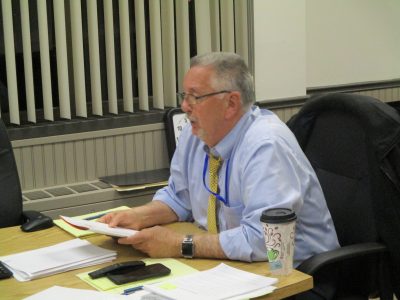Mt. Pleasant Retains Engineers to Address Flooding, Pursue Grant Money
News Based on facts, either observed and verified directly by the reporter, or reported and verified from knowledgeable sources.

Mount Pleasant officials have retained a local engineering firm to analyze how some of the flooding that has plagued areas of town after recent storms can be mitigated in the future.
Last week the Town Board reviewed steps with John Kellard and Joseph Cermele of the Armonk-based Kellard Sessions Consulting in hopes of finding a solution that will alleviate the inundation in mainly low-lying areas of town.
Kellard said in the past 50 years the town has undertaken four major studies that have identified the problem, with the most effective step appearing to be the replacement of four culverts in the town. One culvert is located near the Metro-North tracks, another across the Saw Mill Parkway, a third on Chelsea Street and another on Amsterdam Avenue.
“You’ve had enough studies done, so all the information is there,” Kellard said. “So it’s a matter of money.”
The first study, completed by Charles Sells in 1972, estimated the four culvert replacements would cost about $300,000 at that time, he said. There were subsequent studies completed on the town’s behalf in 1977, 1994 and 2006, with the latter study estimating the cost at $1.2 million, Kellard explained.
He projected the job would probably run between $3 million and $4 million today.
“It’s a big project to get rid of flooding completely,” Kellard told the board. “But then there’s options where you might not put the culverts in on the railroad and get some stormwater (retention) ponds. You can’t lower the water as much, but you lower it to a point where it’s a benefit to some of the houses.”
Flood-prone areas of Mount Pleasant, which have included portions of Hawthorne, have been inundated with greater frequency recently. On July 18, Supervisor Carl Fulgenzi declared a state of emergency after a deluge hit the town. Some of the same locations that were underwater then, experienced additional flooding during the Sept. 29 storm.
If the culvert project were to be pursued the town would need the cooperation of New York State and the MTA because all four culverts fall in those entities’ jurisdictions.
Even if the town and its representatives could convince the state and MTA to do the work, there’s the issue of money and who pays for it. Cermele recommended the town retain a grant writer because there are funding sources available where municipalities can apply for money from various levels of government. However, writing grant applications is a specialty that requires someone who is experienced, he said.
Fulgenzi said it’s frustrating that the previous studies identified a solution but previous boards decided against moving forward with the plans when the cost was far lower. Now the price is exponentially higher, he said.
“We’re going to have to make these improvements wherever it’s feasible,” Fulgenzi said. “I understand that working with the state and the MTA is going to be a challenge, but they’re all aware of this. It’s not anything new to them.”
Councilwoman Laurie Rogers Smalley said she’s heard that the recently completed work to help ease flooding on the Saw Mill Parkway may have intensified some of the most recent episodes. She asked the engineers whether that can be proven, and if it can, whether the state can be convinced to contribute to the work.
Similar sentiments were voiced in 1977, six years after the completion of the Hawthorne interchange near where the Taconic Parkway meets the Sprain Parkway, the likely cause of additional flooding elsewhere in town, Kellard said. No assistance came from the state.
“When they built the interchange, they filled in a lot of wetlands that used to hold a lot of the water on the other side of the railroad tracks,” he said. “In ’77 they were saying let’s go tell the state they did this.”
Cermele added that while the increasing frequency of heavy rains may not be playing a role in the flooding, the intensity of rain into a compressed amount of time could be a problem. While mitigation has generally used the 100-year storm event, the recent 24-hour rainfall totals in town have not reached that threshold; however, the rain that does fall has been in shorter time periods, overwhelming drainage and areas susceptible to flooding, he said.
The engineers indicated they will meet with Town Engineer David Smyth and come up with a game plan and report back to the Town Board. They will also recommend professional grant writers that officials could consider retaining to help them pursue money.
Fulgenzi said going after grants is one of the board’s top priorities.
“We’ve talked about it for too many years,” Fulgenzi said. “Now we have to move forward and do something.”

Martin has more than 30 years experience covering local news in Westchester and Putnam counties, including a frequent focus on zoning and planning issues. He has been editor-in-chief of The Examiner since its inception in 2007. Read more from Martin’s editor-author bio here. Read Martin’s archived work here: https://www.theexaminernews.com/author/martin-wilbur2007/
